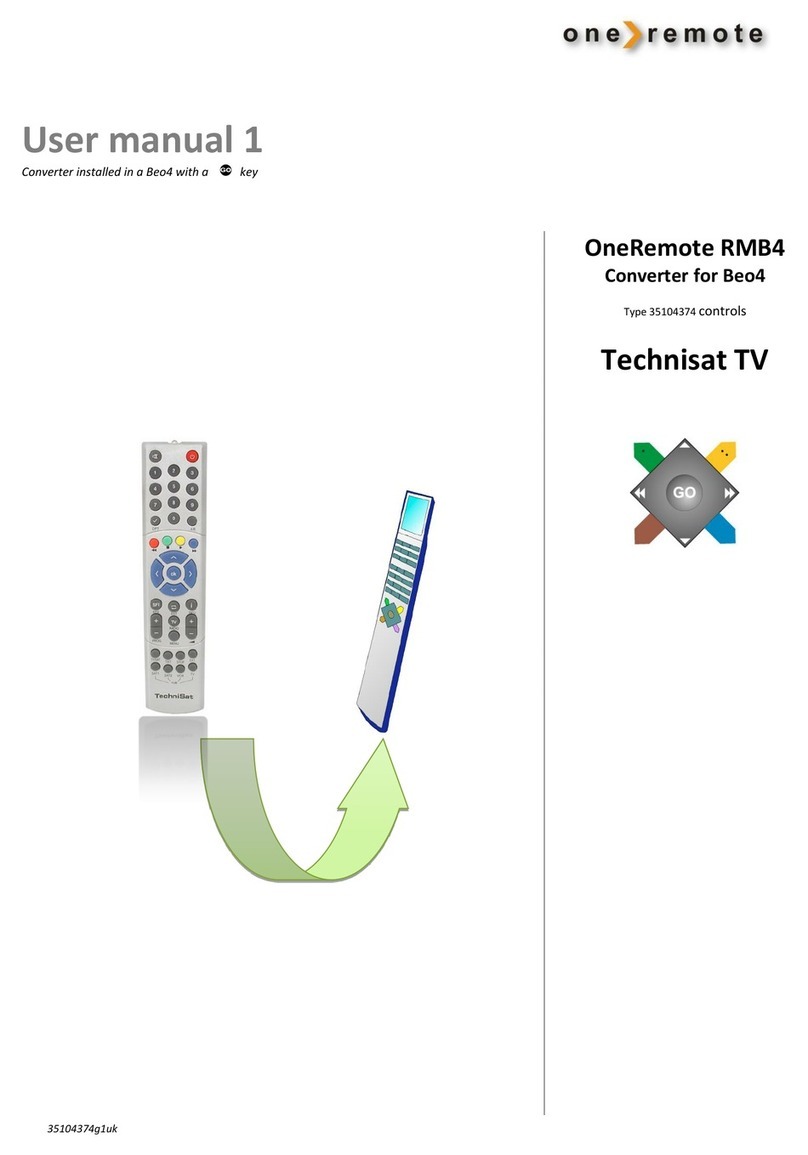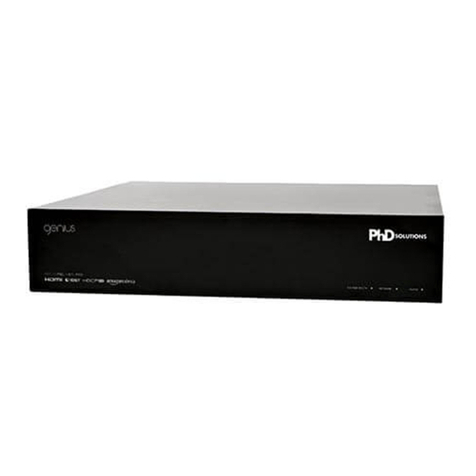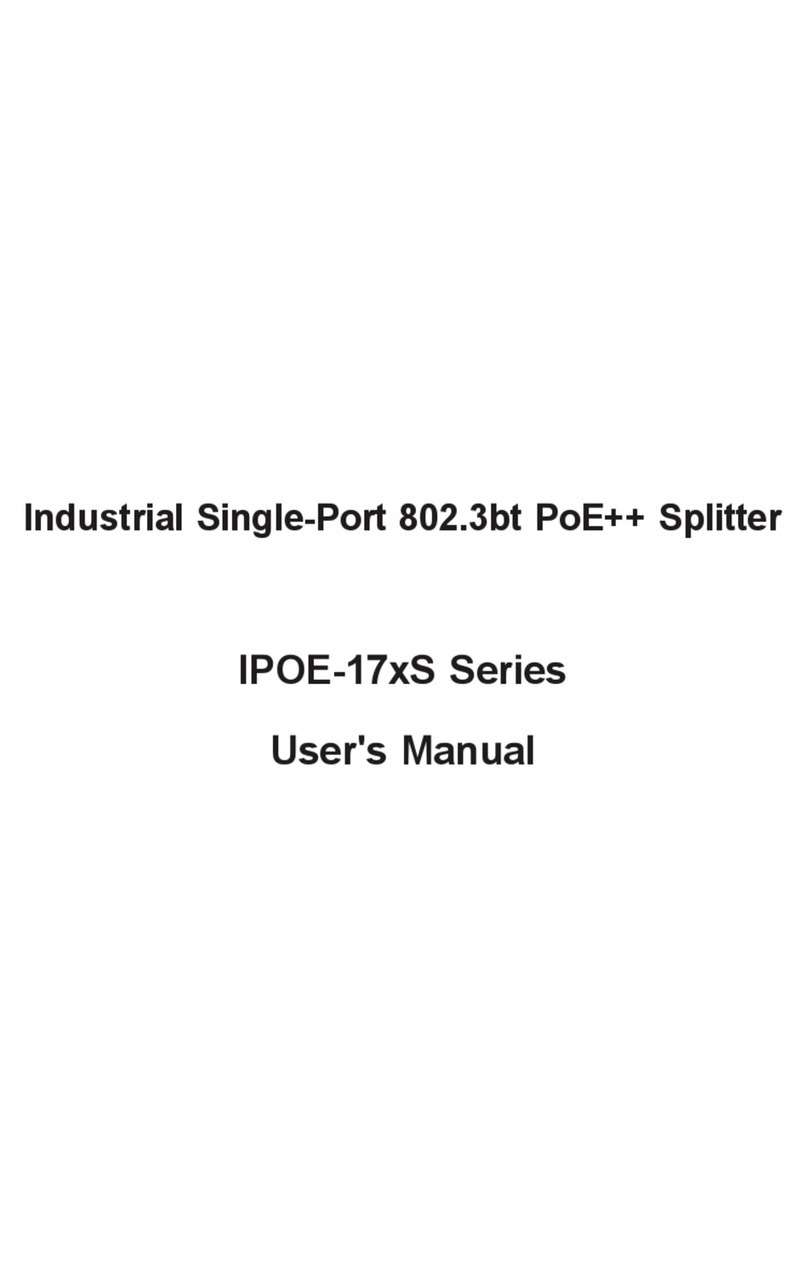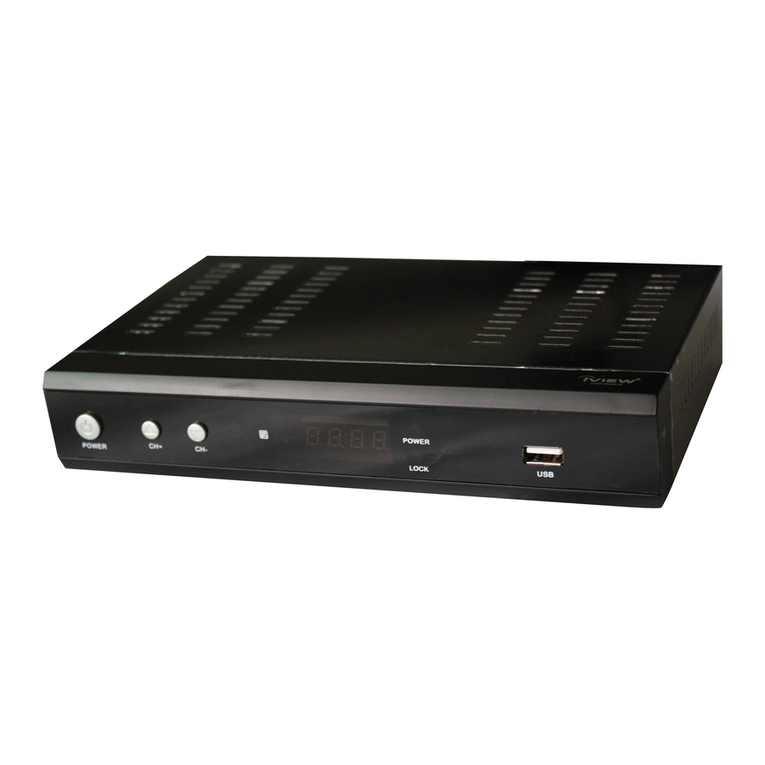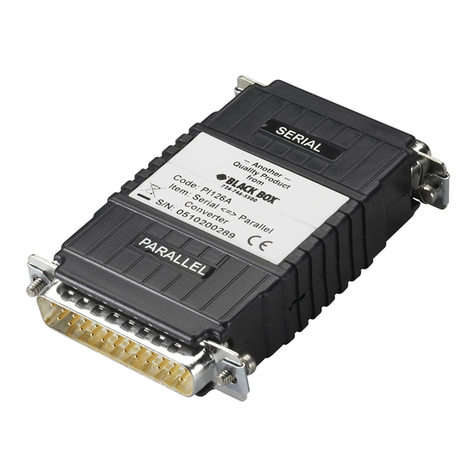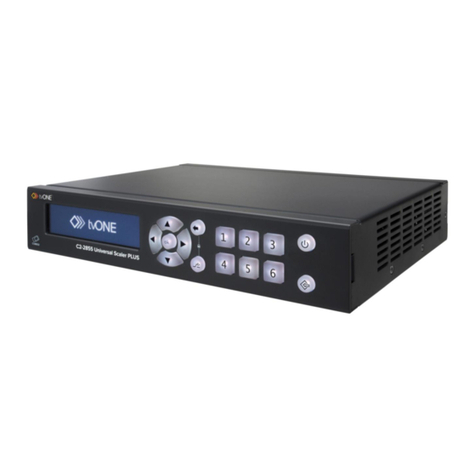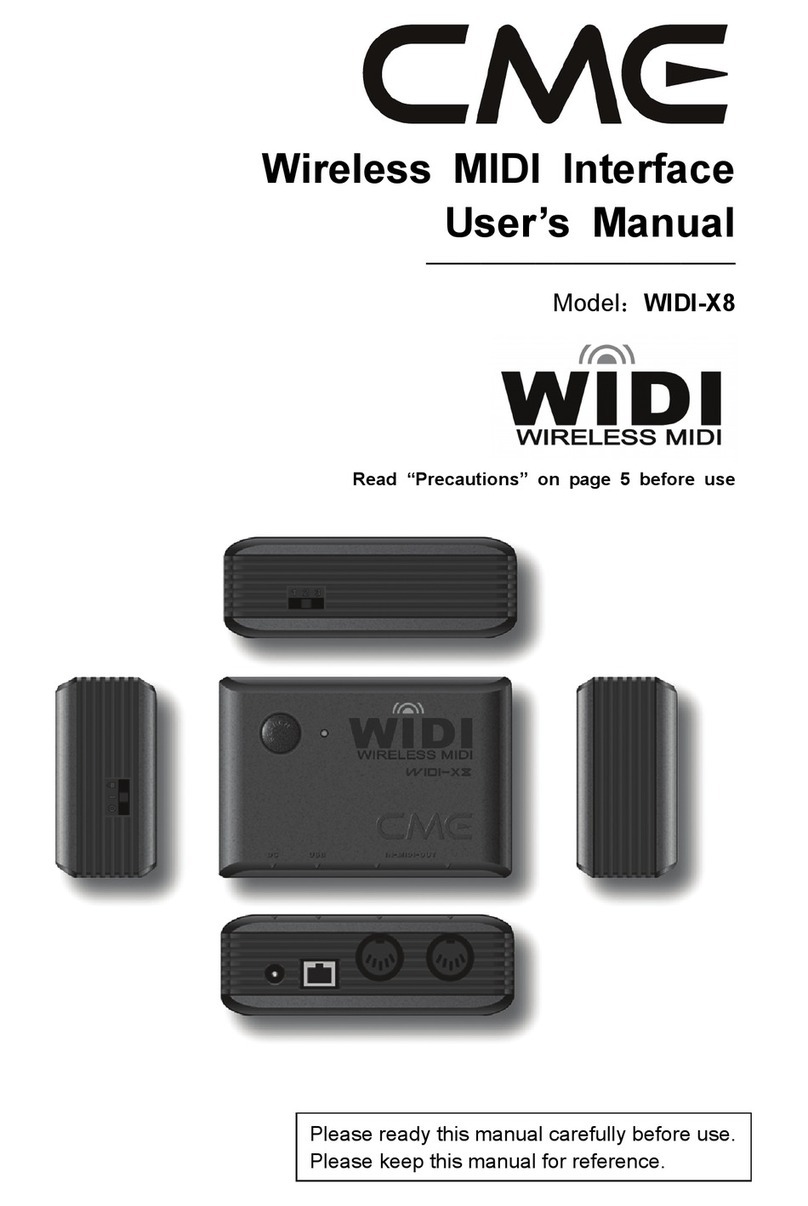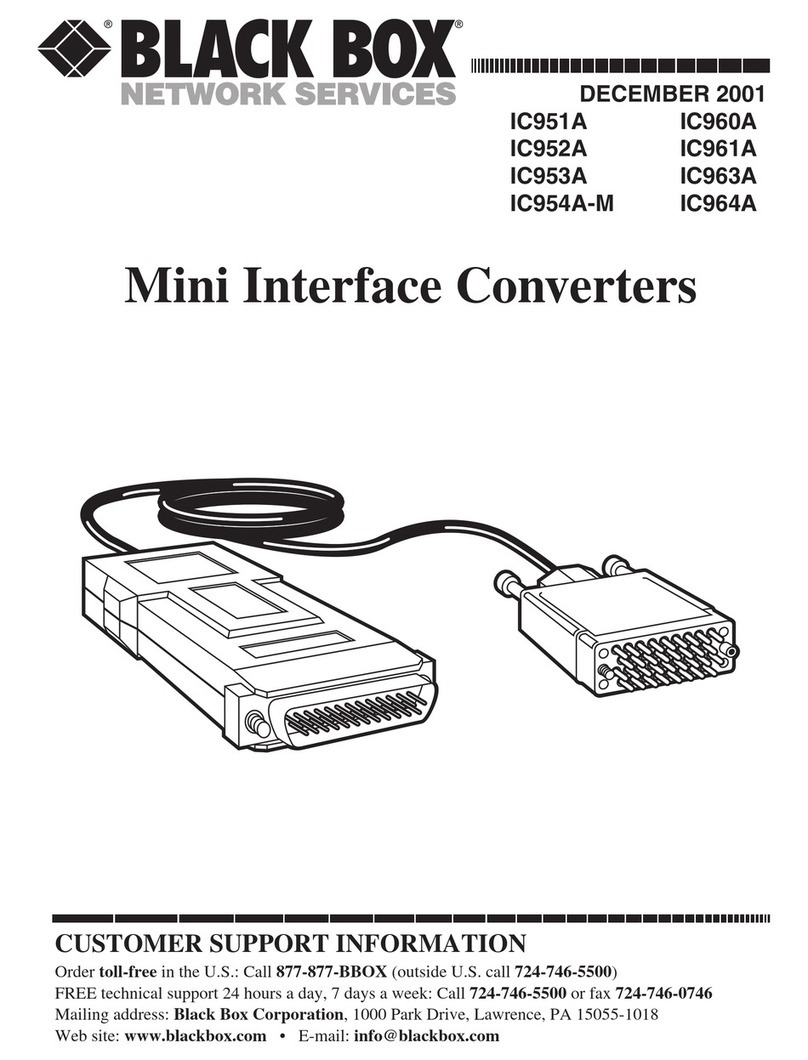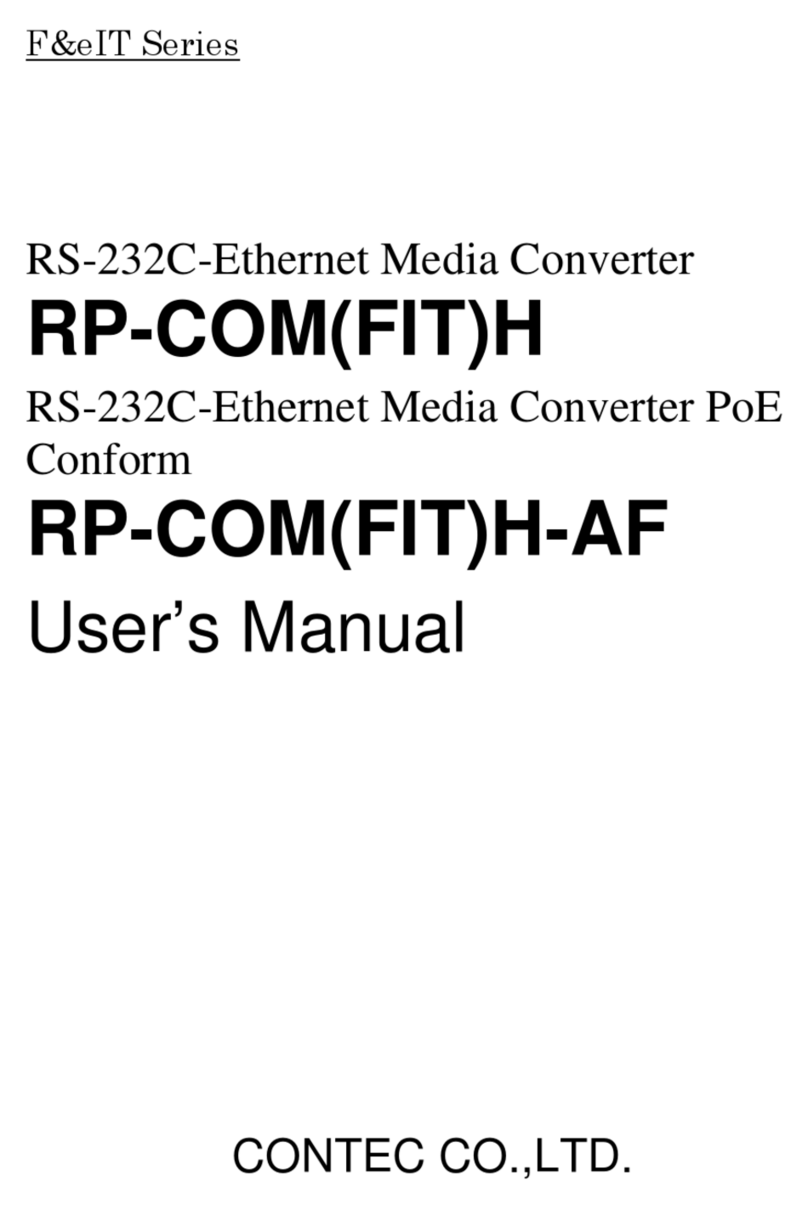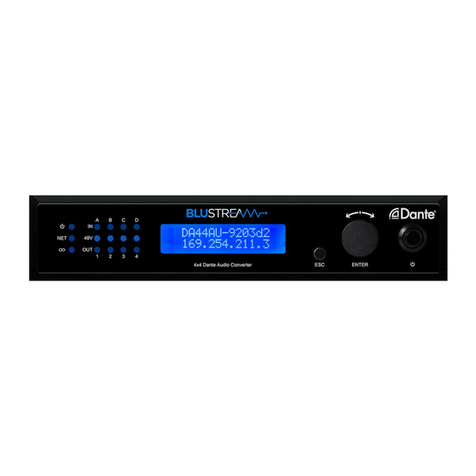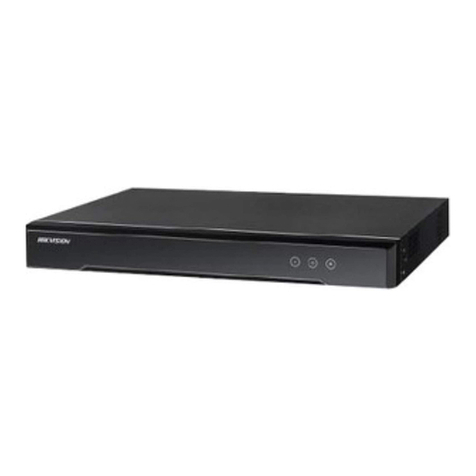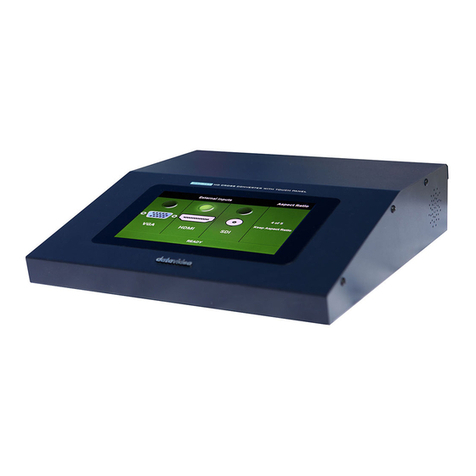Leader Electronics Corp. LT 443D User manual

LT 443D
INSTRUCTION MANUAL
MULTIFORMAT
VIDEO GENERATOR

Page composition of a TABLE OF CONTENTS
■MAINFRAME
LT 443D ............................................................................................................................ 2-1
■UNIT INSTALLATION / REPLACEMENT ......................................................................... I-1
■GENLOCK UNIT
LT 443D-GLA ............................................................................................................... GLA-1
■HD-SDI UNIT / HD-SDI & BLACK UNIT
LT 443D-HD / LT 443D-HDB ................................................................................. HD/HDB-1
■ANALOG BLACK UNIT
LT 443D-BL .....................................................................................................................BL-1
■SD-SDI UNIT / SD-SDI & BLACK UNIT
LT 443D-SD / LT 443D-SDB ..................................................................................SD/SDB-1
■LOGO MARK DISPLAY FUNCTION
LT 443D-HD / HDB / SD / SDB ..................................................................... LOGO MARK-1
■DIGITAL AUDIO UNIT
LT 443D-DA ................................................................................................................... DA-1
■ANALOG AUDIO UNIT
LT 443D-AA ................................................................................................................... AA-1
■ANALOG COMPOSITE UNIT
LT 443D-CS ................................................................................................................... CS-1
■LIST OF BLACK SIGNAL FORMAT ............................................................................. BF-1
■MENU TREE .................................................................................................................. MT-1

TABLE OF CONTENTS
GENERAL SAFETY SUMMARY ...................................................................................................... I
1. INTRODUCTION .................................................................................................................. 1-1
1.1 Scope of Warranty........................................................................................................ 1-1
1.2 Operating Precautions ................................................................................................. 1-1
1.2.1 Line Voltage and Fuse ..................................................................................... 1-1
1.2.2 Maximun Allowable Input Voltage .................................................................... 1-2
1.2.3 Shorting the Output Connectors, Reverse Voltage .......................................... 1-2
1.2.4 Installation........................................................................................................ 1-2
1.2.5 Mechanical Shock............................................................................................ 1-2
1.2.6 Calibration........................................................................................................ 1-2
1.2.7 Routine Maintenance ....................................................................................... 1-2
2. SPECIFICATIONS ................................................................................................................ 2-1
2.1 Description ................................................................................................................... 2-1
2.2 Features ....................................................................................................................... 2-1
2.3 Specifications ............................................................................................................... 2-2
2.3.1 Compartment ................................................................................................... 2-2
2.3.2 LCD Panel ....................................................................................................... 2-2
2.3.3 Internal Clock ................................................................................................... 2-2
2.3.4 Memory Card Slot ............................................................................................ 2-2
2.3.5 External Interface............................................................................................. 2-2
2.3.6 General Specifications ..................................................................................... 2-2
2.4 Options ......................................................................................................................... 2-3
2.4.1 LT 443D-70 (NATURAL PICTURE Memory: Option 70) .................................. 2-3
2.4.1.1 Description ................................................................................................ 2-3
2.4.1.2 Specifications ............................................................................................ 2-3
2.5 Plug-In Units .................................................................................................................. 2-4
2.5.1 Plug-In Units for LT 443D ................................................................................... 2-4
2.5.2 LT 443D-GLA ..................................................................................................... 2-5
2.5.2.1 Description ................................................................................................ 2-5
2.5.2.2 Specifications ............................................................................................ 2-5
2.5.3 LT 443D-HD/HDB ............................................................................................... 2-6
2.5.3.1 Description ................................................................................................ 2-6
2.5.3.2 Specifications ............................................................................................ 2-6
2.5.4 LT 443D-BL ...................................................................................................... 2-6
2.5.4.1 Description ................................................................................................ 2-6
2.5.4.2 Specifications ............................................................................................ 2-7

2.5.5 LT 443D-SD/SDB ............................................................................................... 2-7
2.5.5.1 Description ................................................................................................ 2-7
2.5.5.2 Specifications ............................................................................................ 2-7
2.5.6 LT 443D-DA ..................................................................................................... 2-7
2.5.6.1 Description ................................................................................................ 2-7
2.5.6.2 Specifications ............................................................................................ 2-8
2.5.7 LT 443D-AA ..................................................................................................... 2-8
2.5.7.1 Description ................................................................................................ 2-8
2.5.7.2 Specifications ............................................................................................ 2-8
2.5.8 LT 443D-CS ..................................................................................................... 2-8
2.5.8.1 Description ................................................................................................ 2-8
2.5.8.2 Specifications ............................................................................................ 2-9
3. PANEL DESCRIPTION ......................................................................................................... 3-1
3.1 Front Panel ................................................................................................................... 3-1
3.2 Rear Panel ...................................................................................................................3-2
4. USING THE MAINFRAME .................................................................................................... 4-1
4.1 Turning Power On ........................................................................................................ 4-1
4.2 Selecting Unit ...............................................................................................................4-1
4.3 Selecting Format .......................................................................................................... 4-2
4.4 Selecting Pattern .......................................................................................................... 4-2
4.5 UTILITY Menu Structure .............................................................................................. 4-2
4.5.1 UTILITY Menu Screen ..................................................................................... 4-2
4.5.2 LCD BACK LIGHT ........................................................................................... 4-2
4.5.3 KEY LOCK SET ............................................................................................... 4-2
4.5.3.1 Key Lock Mode Set With Menu ................................................................ 4-2
4.5.3.2 Setting KEY LOCK ON ............................................................................. 4-3
4.5.3.3 Setting KEY LOCK OFF............................................................................ 4-3
4.5.4 Using Front Panel KEY LOCK Switch ............................................................. 4-3
4.5.5 PRESET/RECALL ........................................................................................... 4-4
4.5.5.1 Selecting the Preset Storage Media ......................................................... 4-4
4.5.5.2 Creating Presets ....................................................................................... 4-4
4.5.5.3 Recalling Presets (ALL Mode) .................................................................. 4-5
4.5.5.4 Recalling Presets (UNIT Mode) ................................................................ 4-6
4.5.5.5 POWER ON RECALL ............................................................................... 4-8
4.5.6 ETHERNET SET ............................................................................................. 4-9
4.5.6.1 Remote Control via ETHER Port .............................................................. 4-9
4.5.6.2 Exiting Remote Control Mode ................................................................. 4-10
4.5.6.3 Remote Control Command ..................................................................... 4-11
4.5.7 VERSION DISPLAY ....................................................................................... 4-17

4.6 Main Menu Structure .................................................................................................. 4-18
4.6.1 Two Modes Selectable With MENU Key........................................................ 4-18
4.6.2 STATUS Display Mode .................................................................................. 4-18
4.6.3 SETTING Menu Mode ................................................................................... 4-19
5. NOTES ON RACK MOUNTING ............................................................................................ 5-1
6. ABOUT RUBBER FEET........................................................................................................ 6-1
7. DATA BACKUP ..................................................................................................................... 7-1
8. DEFAULT SETTINGS ........................................................................................................... 8-1
8.1 Default Settings for All Data [MENU] + [FORMAT]....................................................... 8-1
8.2 Default Settings for Selected Data [MENU] + [ENTER] ............................................... 8-1
9. MAINTENANCE .................................................................................................................... 9-1
9.1 Preventing Power Cord Disconnection ........................................................................ 9-1
9.1.1 Connecting the Power Cord............................................................................. 9-1
9.1.2 Disconnecting the Power Cord ........................................................................ 9-2

— I —
The sections where this symbol is marked in this manual or
instrument, if not correctly performed or practiced, could result in
personal injury or cause serious danger to the instrument. Misuse
could also produce unintentional movement to create an
operational impediment on the instrument or other products that
might be connected to it.
Be sure to refer to the safety precautions in this manual to safely
use the part of the instrument where the symbol is marked.
Warning statements identify warning conditions that if
disregarded
or not correctly performed or adhered to, could result in serious
personal injury or even loss of life.
Caution statements identify caution conditions that if disregarded
or not correctly performed or adhered to, could result in personal
injury or damage to the instrument.
<Symbol>
<Te r m >
<Te r m >
WARNING
CAUTION
GENERAL SAFETY SUMMARY
■To Avoid Personal Injury
It is recommended that only qualified personnel with technical knowledge use this
instrument only after reading and fully understanding all functions of the instrument
described this instruction manual.
This instrument is not designed and manufactured for consumers.
If you do not have enough knowledge on electricity, to avoid personal injury and
prevent damage to this product, please be sure to use this product only under the su-
pervision of an engineer who has sufficient knowledge about electronics.
■Precautions on Contents
Should you find the contents in this manual and any of its technical terms confusing,
please feel free to contact your local LEADER agent.
■Symbols and Terms
Following terms and symbols indicate necessary warnings and cautions used in this
manual and on the product are there for safe operation.

— II —
WARNING
GENERAL SAFETY SUMMARY
Review the following safety precautions to avoid operator's injury and loss of life
and prevent damage and deterioration to this instrument. To avoid potential hazards, use
this product as specified.
■Warnings on the Cases and Panels of the Instrument
Operator should not remove any cases or panel for any reasons. If you touch
inside the instrument it could result personal shock or fire hazard. Refrain
from spilling any liquid on or inserting anything flammables or piece of metal
into the ventilation of the instrument. Such actions could cause fire, shock,
malfunction and be an accident hazard while the power is on.
■Warnings on Power Line
●Make sure to connect only to the rated power line voltage. Excess
voltage may cause fire.
Confirm the voltage of the commercial power line before connecting the AC power
cord. The power frequency of the power line should be 50/60 Hz.
●Warning on the Power Cord
Use only the optional power cord that is attached to this instrument. The use of the
power cord other than that attached could cause fire hazard.
If the attached cord is damaged stop using it and contact your local LEADER
agent. Should you use a damaged cord, it could cause a shock or create a fire
hazard. When you pull out the cord be sure to hold it by plug and pull from the
socket not by holding the cord wire.
●Cover/Inlet stopper
Use the Cover/Inlet stopper that comes with the package only after establishing
a means to immediately shut down the power supply when a malfunction
occurs on the LT 443D.

— III —
WARNING
GENERAL SAFETY SUMMARY
■Warning on Installation Environments
●About the Operating Temperature Range
Operate the instrument between the temperature range of 0 to 40 °C. Operating the
instrument at higher temperatures could cause a fire hazard.
Rapid changes of temperatures from cold to warm can create internal moisture or
condensation and could damage the instrument. If there is a possibility of moisture
condensation allow the instrument to sit for 30 minutes without the power on.
●About the Operating Humidity Range
Operating humidity range is ≤90 % RH.
Do not operate the instrument with wet hands. This could cause a shock and fire
hazard.
●About the Operation in the Presence of Gasses
Operating the instrument in and near the presence or storage locations of flam-
mable, explosive gasses or fumes could create an explosion and fire hazard. Do not
operate the instrument anywhere near such environments.
●Avoid Insertions
Do not insert metals or flammable objects or drop liquid on or into the instrument.
To do so could cause fire, shock, malfunction and create a dangerous accident haz-
ard.
■Abnormal symptom
Incase of smoke, fire, or abnormal smell while operating this instrument,
immediately disconnect the power cord from the mains. Otherwise, you run
the risk of fire or electrical shock. If the trouble cannot be solved, contact
your local LEADER agent.
■Warning about Ground
The instrument has a ground terminal to avoid electric shock hazard and to protect the
instrument from damage. Ensure that the product is properly grounded for safe opera-
tion.

— IV —
CAUTION
GENERAL SAFETY SUMMARY
■Caution on Input/Output Terminals
Input Terminals are rated with a maximum input. Do not supply an input over the
specified rating in the standard section of the instruction manual. Also, do not supply
external power to Output terminal, this could cause the instrument to malfunction.
■Caution when Not Using the Instrument for a Long Time
Make sure to disconnect the power cord from the socket when you do not use the
instrument for a long time.
Please conform to the above warnings and cautions for safe operation. There are cautions in
each area of this instruction manual, so please conform to each caution. If you have any
questions about this manual, please feel free to contact your local LEADER agent.

1-1
1. INTRODUCTION
Thank you for purchasing LEADER’s measuring instruments.
Please read this instruction manual carefully to ensure correct and safe operation.
If you have any difficulties or questions on how to use the instrument after you have read this
manual, please feel free to contact your local LEADER agent.
1.1 Scope of Warranty
This LEADER instrument has been manufactured under the strictest quality control
guidelines. LEADER shall not be obligated to furnish free service during the warranty
period under the following conditions.
1. Repair of malfunction or damages resulting from fire, natural calamity, or improper
voltage applied by the user.
2. Repair of an instrument that has been improperly repaired, adjusted, or modified by
personnel other than a factory-trained LEADER representative.
3. Repair of malfunctions or damages resulting from improper use.
4. Repair of malfunctions caused by devices other than this instrument.
5. Repair of malfunctions or damages without the presentation of a proof of purchase or
receipt bill for the instrument.
1.2 Operating Precautions
WARNING
1.2.1 Line Voltage and Fuse
Confirm that the power line voltage is correct before connecting the power cord.
The voltage range and fuse rating are indicated on the rear panel.
The instrument must be connected to the rated line voltage and line frequency of 50 Hz
to 60 Hz.

1-2
CAUTION
1.2.2 Maximum Allowable Input Voltage
The maximum allowable input voltage to the input connector is shown below.
Do not apply excessive voltage to prevent damage to the instrument.
1.2.3 Shorting the Output Connectors, Reverse Voltage
• Shorting the output connectors
Do not short any output connectors to prevent damage the instrument.
• Applying external voltage
Do not apply external voltage to the output connectors, it can cause trouble.
1.2.4 Installation
Do not use the instrument in the following environments.
• High temperature environments
Do not place the instrument under direct sunlight or near a heater (e.g., stove).
Do not move the instrument from cold to warm environment abruptly, it may cause
condensation.
Operating temperature range: 0 to 40 ˚C
• High humidity environments
Do not place the instrument in the high humidity environment (e.g., bathroom, near a
humidor).
Operating humidity range: ≤90 % RH
• Dusty environments
1.2.5 Mechanical Shock
Please be careful not to expose the instrument to other forms of severe mechanical shock
as this product contains shock sensitive precise parts.
1.2.6 Calibration
When calibration or service is required, contact your local LEADER agent.
1.2.7 Routine Maintenance
When cleaning the instrument, do not use such solvents as thinner or benzol which will
remove paint or damage the plastic surface. Use a soft cloth dampened with neutral
detergent.
Do not drop water or detergent, or insert metal object into the instrument while cleaning.
Otherwise, you run the risk of electrical shock or fire.
Input Connector
GENLOCK IN
Maximum Allowable Input Voltage
±4.5V (DC + peak AC)

2-1
2. SPECIFICATIONS
2.1 Description
The LT 443D Signal Generator can be flexibly used for the multiformat digital broadcast
systems. Various plug-in units enable the output of SDI signals (i.e., HDTV, SDTV), sync
signals, and analog signals. By using these signals and genlock functions, users can
customize this signal generator as desired.
2.2 Features
• Plug-in units provide various functions
Since up to four plug-in units can be installed in the mainframe (consisting of a power
supply, main signal generator, and controller), users can customize this signal generator
as desired.
• Applicable to multiformat HDTV
For the SDI signals, HDTV 14 format unit and 525 line/625 line SDTV unit are provided.
The NTSC/PAL analog video signal unit is also available.
Since each unit can output the signal simultaneously, a multiformat system can be
constructed to satisfy user’s requirements.
•Various sync outputs
Two units can simultaneously output HD signals with 74.25 MHz clock and 74.25/1.001
MHz clock.
•Easy-to-use sync signals
For today’s modern age of digital TV systems, BB signal (for NTSC, PAL) and HDTV tri-
level sync signals can be generated from the Analog BB Unit.
• Ethernet provided
Since the ethernet capability is provided as standard. This feature can remotely control
various functions and monitor he genlock status.
•User-friendly operability
LEADER’s traditional design and operability concepts are also reflected in this
instrument. User-friendly operation includes significantly reduced power-on initialization
time is advantageous to a high-performance instrument.

2-2
2.3 Specifications
2.3.1 Compartment
Number of compartments 4
ID Function Automatically identifies the unit installed.
*2 Refer to Section 2.5 and specifications of each unit.
2.3.2 LCD Panel
Number of Characters 20 characters x 2 lines can be displayed (w/backlight).
2.3.3 Internal Clock
Internal Reference Frequency 27 MHz
2.3.4 Memory Card Slot
Function Storing/reading preset data
Reading logo mark data
Reading NATURAL PICTURE data *3
Applicable Card Compact flash memory card (CFA TYPE-1) *4
*3 The NATURAL picture function is only usable when the LT 443D-70 Option is installed
in the mainframe.
*4 No compact flash memory card is supplied as standard accessory.
Memory cards produced by following manufacturers should be procured (as of August
2002):SanDisk
*5 A microdrive can’t be used.
2.3.5 External Interface
Ethernet 10/100 Base T (Automatic selection)
Function Transferring operation status (e.g., genlock status)
Remote control (e.g., pattern switching)
USB (Universal Serial Bus) Applicable to USB 1.1
Function This function will be supported. (Hardware is installed as
standard.)
2.3.6 General Specifications
Environmental Conditions
Operating Temperature Range 0 to 40 ˚C
Operating Humidity Range ≤90% RH (without condensation)
Spec-Guaranteed Temperature Range 10 to 35 ˚C
Spec-Guaranteed Humidity Range ≤85% RH (without condensation)
Operating Environment Indoor use
Operating Altitude Up to 2000 m
Overvoltage Category w
Pollution Degree 2
Power Requirements 90 to 250 VAC, 50/60 Hz
Power Consumption Approx. 150 W max. (Approx. 75 W max. *5)
Dimensions and Weight 426 (W) x 44 (H) x 560 (D) mm,
Approx. 7 kg *5

2-3
Accessories Power cord .............................................. 1
Cover/Inlet Stopper .................................. 1
Rack Support (Right and left) .................. 1
Screw (for rack support) .......................... 4
About Rubber Feet .................................. 5
Instruction Manual ................................... 1
LOGO MARK SOFTWARE CD-R ........... 1
*5 When four plug-in units (i.e., LT 443D-HD, LT 443D-SD, LT 443D-BL, LT 443D-GL)
are installed.
2.4 Options
2.4.1 LT 443D-70 (NATURAL Picture Memory: Option 70)
2.4.1.1 Description
This option adds the NATURAL picture pattern output capability to the LT 443D
mainframe.
A compact flash memory card is used as an additional memory to store the NATURAL
picture pattern.
2.4.1.2 Specifications
(1) NATURAL PICTURE Memory
Additional memory ≥16 M byte (Compact flash memory card)
(2) Number of Storable Screens
In case of 32 M byte memory is used: *6
1920 (H) x 1080 (V) format Up to 3 screens
720 (H) x 574 (V) format Up to 19 screens
*6 The number of storable screens to the memory is described above.
When the power is turned on or the screen size is changed, data contained in
this memory is transferred to the RAM in the plug-in unit.
Refer to the unit specifications for the number of storable screens to the RAM.
Any combination of the screen sizes can be stored.
The same size of NATURAL picture data can only be stored; difference size of
screens cannot be stored.
(3) Number of Video Data Quantitative Bits
Y, Cb, Cr10 bits
(4) File Format
Before Conversion Bit map format (.bmp)
8 bits for each R, G, B component
After Conversion Dedicated format for LT 443D (.img) *7
10 bits for each Y, Cb, Crcomponent
*7 Converted by using Windows (R) application software supplied.

2-4
(5) Conversion of Color Matrix
Colorimetry parameter used to convert data from R, G, B (eight bits data) to Y, Cb,
Cr(10 bits data) by using the Windows (R) application software.
1080/720 System Rec. ITU-R BT. 709-3 Part II
1035 System SMPTE 240M
SD 525/SD 625 System SMPTE 125M
NTSC System SMPTE 170M
PAL System Rec. ITU-R BT. 470-6
(6) Transferring NATURAL Picture Pattern
Memory Picture data should be stored in a compact flash memory
card.
(Procure a compact flash memory card on your side. At
least 16 M bytes required)
2.5 Plug-In Units
2.5.1 Plug-In Units for LT 443D
Up to four units can be installed.
Table 2-1 lists installable combination of the unit and UNIT compartment. *8
Compartment
Model
LT 443D-GLA
LT 443D-GL
LT 443D-HD/HDB
LT 443D-BL
LT 443D-SD/SDB
LT 443D-DA
LT 443D-AA
LT 443D-CS
UNIT 1
Yes *8
Yes *8
Yes
Yes
Yes
Yes
Yes
Yes
UNIT 2
No
No
Yes
Yes
Yes
Yes
Yes
Yes
UNIT 3
No
No
Yes
Yes
Yes
Yes
Yes
Yes
UNIT 4
No
No
Yes
Yes
Yes
Yes
Yes
Yes
Table 2-1 Installable unit and compartment
*8 The LT 443D-GLA and the LT 443D-GL can only be installed in the UNIT 1
compartment.
*Note: The firmware version 3.0 and later is used for the LT 443D-GLA.
The firmware version can be confirmed on the VERSION DISPLAY in
MAINFRAME menu.

2-5
2.5.2 LT 443D-GLA
2.5.2.1 Description
This unit provides genlock capability to lock the LT 443D mainframe with the external
reference signal, and three independent black signal generators.
The NTSC/PAL black burst signals, principal 20 types of HDTV analog tri-level sync
signal formats, and 525p/625p analog sync signals can be used as an external
reference signal.
The following black burst signal formats can be selected.
For NTSC/PAL system, black burst signal with field reference pulse is provided. For
NTSC system, black burst with 10-field sequence identification conforming to the
SMPTE 318M standards is provided.
The instrument continues operation since the flywheel mode is provided even if the
external reference signal is accidentally removed in genlock mode. By logging the
genlock status, the time can be obtained when the external reference signal is
removed. The log information can be stored on the CF CARD.
The genlock timing can be adjusted for the entire color frame range when the NTSC/
PAL black burst signal is applied; entire frame range when the HDTV analog tri-level
sync signal is applied.
Three black burst signal output systems with selectable formats are available as
follows:
For NTSC/PAL system, standard black burst signal and black burst signal with field
reference pulse are provided. For NTSC system, black burst with 10-field sequence
identification conforming to the SMPTE 318M standards, 525p/625p analog sync
signal, and HDTV analog tri-level sync signal are provided.
The format and output signal timing of each output can be respectively set.
The black signal timing can be adjusted for the entire color frame range when the
NTSC/PAL black burst signal is applied; entire frame range when the HDTV analog tri-
level sync signal is applied.
2.5.2.2 Specifications
(1) Genlock Function
Reference Input Signal Level
• HDTV Positive polarity: 300 mV
Negative polarity: -300 mV
• 525p/625p -300 mV
• NTSC -286 mV
• PAL -300 mV
Input Connector BNC (75 Ω, loop through)

2-6
(2) Analog Sync Signal Output
Sync Level (into 75 Ω)
• HDTV Positive polarity: 300 mV ±6 mV
Negative polarity: -300 mV ±6 mV
• 525p -300 mV ±6 mV
• 625p -300 mV ±6 mV
• NTSC 40 IRE ±1 IRE
• PAL -300 mV ±6 mV
Output Connector BNC (BLACK 1/BLACK 2/BLACK 3)
Number of Outputs 1 each
2.5.3 LT 443D-HD/HDB
2.5.3.1 Description
The LT 443D-HD (HD-SDI Unit) and LT 443D-HDB (HD-SDI & BLACK Unit) add the
capability to output 14 types of HD-SDI signal formats to the LT 443D mainframe.
Various functions (e.g., ID character display, simple motion pictures, embedded audio,
NATURAL picture pattern *1) are provided.
The LT 443D-HDB (HD-SDI & BLACK Unit) can output HD-SDI black signal
independently of the HD-SDI test signals.
*1: The option should be installed.
2.5.3.2 Specifications
(1) Applicable Format
1035i/60, 1035i/59.94,
1080i/60, 1080i/59.94, 1080i/50,
1080p/30, 1080p/29.97, 1080p/25,
1080p/24, 1080p/23.98,
1080PsF/24, 1080PsF/23.98,
720p/60, 720p/59.94,
The verification has not completed though the following formats were built in since
the firmware version 3.3 of the LT 443D.
720p/24, 720p/23.98, 720p/29.97,
720p/50, 720p/30, 720p/25
(2) HD-SDI Video Output 1 system, 2 outputs (75 Ω, BNC)
HD-SDI Black Output 1 system, 2 outputs (75 Ω, BNC)
(The HD-SDI black signal is only output when the LT 443D-HDB is installed.)
2.5.4 LT 443D-BL
2.5.4.1 Description
This unit outputs the 20 format HDTV analog tri-level sync signal, 525p/625p analog
sync signals, and NTSC/PAL black burst signals.
Three independent output systems (six outputs, two outputs per system) are provided
to output multiformat black sync signal.
The format and output signal timing can be respectively set each output.

2-7
2.5.4.2 Specifications
(1) Sync Level (into 75 Ω)
• HDTV Positive polarity: 300 mV ±6 mV
Negative polarity: -300 mV ±6 mV
• 525p -300 mV ±6 mV
• 625p -300 mV ±6 mV
• NTSC 40 IRE ±1 IRE
• PAL -300 mV ±6 mV
(2) Output Connector BNC (BLACK 1, 2/BLACK 3, 4/BLACK 5, 6)
(3) Number of Outputs 2 each
2.5.5 LT 443D-SD/SDB
2.5.5.1 Description
The LT 443D-SD (SD-SDI Unit) and LT 443D-SDB (SD-SDI & BLACK Unit) add the
capability to output 525/625 line format SD-SDI signal (4:2:2 component signal) to the
LT 443D mainframe.
Various functions (e.g., ID character display, simple motion pictures, embedded audio,
NATURAL picture pattern *1) are provided.
The LT 443D-SDB (SD-SDI & BLACK Unit) can output SD-SDI black signal
independently of the SD-SDI test signals.
*1:The option should be installed.
2.5.5.2 Specifications
(1) Applicable Format 525i/59.94-270 MHz, 625i/50-270 MHz
(2) SD-SDI Video Output 1 system, 2 outputs (75 Ω, BNC)
SD-SDI Black Output 1 system, 2 outputs (75 Ω, BNC)
(The SD-SDI black signal is only output when the LT 443D-SDB is installed.)
2.5.6 LT 443D-DA
2.5.6.1 Description
Installing the LT 443D-DA Digital Audio Unit in the LT 443D mainframe can output
AES/EBU digital audio signals (four systems), silence signals (one system), and 48
kHz word clock signals.
The AES/EBU signal characteristics (e.g., output level, frequency) can be
independently set for each output system.
The sampling frequency is synchronized with the video signal of plug-in unit installed
in the mainframe.

2-8
2.5.6.2 Specifications
AES/EBU Digital Audio Output
• Number of Outputs 4 (2-channel output)
• Output Impedance 75 Ωunbalanced
• Output Amplitude 1 Vp-p (into 75 Ω)
• Output Connector BNC
Silence Signal (DARS grade 2) Output
• Number of Outputs 1 (2-channel output)
• Output Impedance 75 Ωunbalanced
• Output Amplitude 1 Vp-p (into 75 Ω)
• Output Connector BNC
48 kHz Word Clock
• Number of Outputs 1
• Output Impedance 75 Ωunbalanced (“1 Vp-p” output)
• Output Amplitude 1 Vp-p (into 75 Ω), 5 V CMOS, selectable
• Output Connector BNC
2.5.7 LT 443D-AA
2.5.7.1 Description
Installing the LT 443D-AA Analog Audio Unit in the LT 443D mainframe can output
analog audio signal (two systems). Output characteristics (e.g., output level,
frequency) can be independently set for each output system. The sound sampling
frequency is synchronized with the video signal of plug-in unit installed in the
mainframe.
2.5.7.2 Specifications
• Number of Outputs 2
• Output Impedance 600 Ω, balanced
• Output Amplitude 0.775 Vrms (into 600 Ωat 0 dBm)
• Output Connector XLR-3P x 2
2.5.8 LT 443D-CS
2.5.8.1 Description
The LT 443D-CS Analog Composite Unit adds the NTSC/PAL analog composite
signal output capability to the LT 443D mainframe. Various functions (e.g., ID
character, simple motion pictures, NATURAL picture pattern *1) are provided.
*1: The NATURAL picture function is only usable when the Option LT 443D-70 is
installed in the mainframe.

2-9
2.5.8.2 Specifications
Test Signal Output
• Number of Outputs 2
• Signal Level 1 Vp-p (into 75 Ω)
Black Signal Output
• Number of Outputs 2 systems (one each)
• Signal Level 1 Vp-p (into 75 Ω)
Horizontal Drive Pulse Output
• Number of Outputs 1
• Signal Level 2 Vp-p (into 75 Ω)
Vertical Drive Pulse Output
• Number of Outputs 1
• Signal Level 2 Vp-p (into 75 Ω)
This manual suits for next models
9
Table of contents


